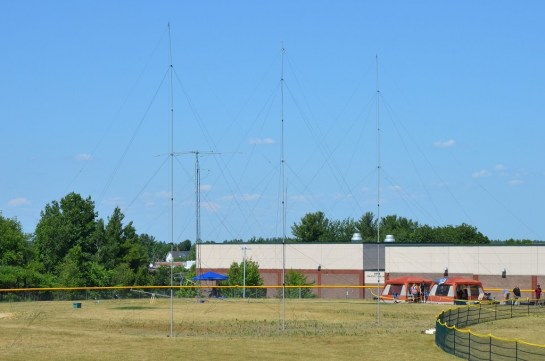
Whether you’re operating at Field Day or a multi/multi contest station, one of the biggest problems is too many stations in a small area. So how do you control interference between radios and still successfully make contacts?
There are several ways you can have multiple transceivers/antennas and still operate without inflicting QRM on everyone. Here are four solutions:
Use Bandpass Filters
Bandpass filters are devices that pass frequencies within a certain range and reject frequencies outside that range. Think of them as gatekeepers at your rig’s antenna terminals that keep out unwanted out-of-band signals and suppress any stray RF harmonics that might interfere with other radios. They’re great for Field Day or multi-op contest stations and are used by operators who want results.
For example, a 40 meter bandpass filter would let signals from 7.0 – 7.3 MHz pass through. DX Engineering has Low Band Systems Bandpass Filters for all the HF bands, with power ratings from 200-1500 watts. Choose one for each band of operation.
Low Band Systems Band Pass Filters can also be used in conjunction with multiplexers, also known as multi-band transmit combiners. This will allow several transmitters to operate simultaneously on one multi-band antenna, such as a tri-band beam, without interfering with each other. These are also sold as multiplexer/filter combo kits, like the DX Engineering Field Day Triplexer Filter Combination Packages DXE-200FD-8X-P.
Bandpass filters work very well when all the radios are on different bands, but they don’t help much if you have radios operating on the same band. For example, 40 meter phone will likely interfere with a 40 meter digital station and vice-versa. In situations like these, you’ll need to incorporate some other strategies as well.
Keep Your Distance
Spreading out your antennas can reduce interference–the more, the better. Doubling spacing distance reduces field strength two to four times. ARRL Field Day rules allow placement of antennas and stations within a 1,000 foot circle, which translates into about 18 acres of space. Keeping your same-band CW and SSB stations at opposite ends of the 1,000 foot circle will make a difference.
It also doesn’t hurt to keep your individual rigs as far apart as practical to avoid transmitter phase noise and receiver desensitization.
Antenna Positioning
Tuned monoband dipoles are less likely to radiate on other bands. Arrange them end-to-end, all facing the same way. Remember, the signal null is at the end of the wires.
Also consider using different antenna polarities–horizontally polarized antennas and vertically polarized antennas. Close in, you may not see much difference in signal attenuation. But if they’re spread out a bit, the 90 degree polarization difference will result in up to a 20 dB signal difference. When planning their placement, be sure the vertical is centered on and positioned broadside to the dipole.
Also pay attention to the coax lines. Some antenna systems are prone to radiating RF on the coax shield. Be sure each antenna feedline has a choke to prevent unnecessary RFI. Ferrite chokes perform better than “ugly baluns” or air-wound coax.
Radios and Settings
Proper radio operation is often overlooked in multiple antenna/transmitter installations. Choosing the right settings can contribute to better operation.
Though this suggestion seems contradictory, turn off the receiver preamplifier. If you’re having trouble hearing a weak signal because of interference, turning on the preamp will only increase both the interference and signal at the same ratio. Instead, use the receiver’s attenuator. You’ll probably copy stations better with the attenuator on. Another apparently contradictory suggestion is to turn off the radio’s noise blanker. Noise blankers tend to make receivers more susceptible to nearby interference.
Reducing the RF gain control will also reduce noise and interference. Find the best balance between noise level and receive sensitivity.
CW and SSB operators on the same band should keep as far away from each other as possible. Maximizing the amount of distance between them on the dial will minimize interference. Having a receiver with high dynamic range will also improve performance in strong signal environments.

